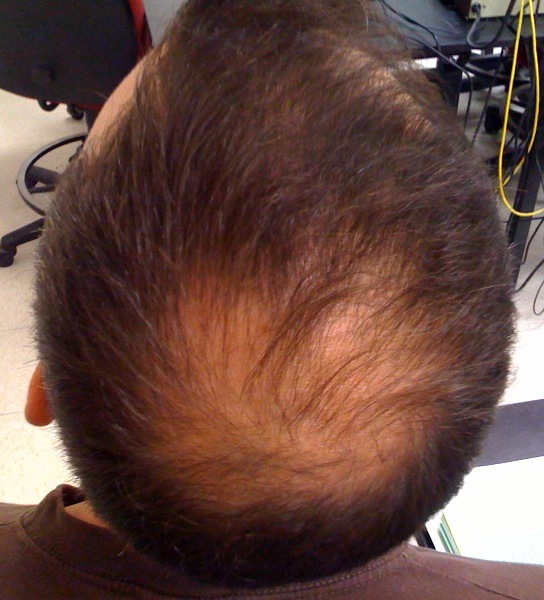Loose anagen syndrome
Editor-In-Chief: Prab R Tumpati, MD
Obesity, Sleep & Internal medicine
Founder, WikiMD Wellnesspedia &
W8MD medical weight loss NYC and sleep center NYC
| Loose anagen syndrome | |
|---|---|

| |
| Synonyms | Loose anagen hair syndrome |
| Pronounce | N/A |
| Specialty | N/A |
| Symptoms | Hair that is easily pulled out, alopecia |
| Complications | N/A |
| Onset | Childhood |
| Duration | Chronic |
| Types | N/A |
| Causes | Genetic factors |
| Risks | Blonde hair, female gender |
| Diagnosis | Trichogram, scalp biopsy |
| Differential diagnosis | Alopecia areata, trichotillomania |
| Prevention | N/A |
| Treatment | Gentle hair care, minoxidil |
| Medication | N/A |
| Prognosis | N/A |
| Frequency | Rare |
| Deaths | N/A |
Loose Anagen Syndrome is a condition that affects the hair growth cycle, resulting in hair that can be easily pulled out. It is most commonly seen in children, particularly girls, and is often diagnosed between the ages of 2 and 6. The condition is usually self-limiting and improves with age.
Symptoms[edit | edit source]
The primary symptom of Loose Anagen Syndrome is hair that can be easily pulled out, often without any pain. The hair may appear thin, sparse, or uneven in length. Other symptoms may include slow hair growth, hair that does not grow long, and hair that is easily damaged.
Causes[edit | edit source]
The exact cause of Loose Anagen Syndrome is not known. It is believed to be due to a defect in the hair shaft, which prevents the hair from anchoring properly to the scalp. This condition is often seen in individuals with a family history of the condition, suggesting a genetic component.
Diagnosis[edit | edit source]
Diagnosis of Loose Anagen Syndrome is typically made through a hair pull test. This involves gently pulling on a small amount of hair. If more than 10% of the hair is easily removed, this may indicate Loose Anagen Syndrome. A microscopic examination of the hair can also be used to confirm the diagnosis.
Treatment[edit | edit source]
There is no specific treatment for Loose Anagen Syndrome. The condition usually improves with age, and most individuals see an improvement by adolescence. In some cases, minoxidil may be used to help stimulate hair growth.
See Also[edit | edit source]
Search WikiMD
Ad.Tired of being Overweight? Try W8MD's physician weight loss program.
Semaglutide (Ozempic / Wegovy and Tirzepatide (Mounjaro / Zepbound) available.
Advertise on WikiMD
|
WikiMD's Wellness Encyclopedia |
| Let Food Be Thy Medicine Medicine Thy Food - Hippocrates |
Translate this page: - East Asian
中文,
日本,
한국어,
South Asian
हिन्दी,
தமிழ்,
తెలుగు,
Urdu,
ಕನ್ನಡ,
Southeast Asian
Indonesian,
Vietnamese,
Thai,
မြန်မာဘာသာ,
বাংলা
European
español,
Deutsch,
français,
Greek,
português do Brasil,
polski,
română,
русский,
Nederlands,
norsk,
svenska,
suomi,
Italian
Middle Eastern & African
عربى,
Turkish,
Persian,
Hebrew,
Afrikaans,
isiZulu,
Kiswahili,
Other
Bulgarian,
Hungarian,
Czech,
Swedish,
മലയാളം,
मराठी,
ਪੰਜਾਬੀ,
ગુજરાતી,
Portuguese,
Ukrainian
Medical Disclaimer: WikiMD is not a substitute for professional medical advice. The information on WikiMD is provided as an information resource only, may be incorrect, outdated or misleading, and is not to be used or relied on for any diagnostic or treatment purposes. Please consult your health care provider before making any healthcare decisions or for guidance about a specific medical condition. WikiMD expressly disclaims responsibility, and shall have no liability, for any damages, loss, injury, or liability whatsoever suffered as a result of your reliance on the information contained in this site. By visiting this site you agree to the foregoing terms and conditions, which may from time to time be changed or supplemented by WikiMD. If you do not agree to the foregoing terms and conditions, you should not enter or use this site. See full disclaimer.
Credits:Most images are courtesy of Wikimedia commons, and templates, categories Wikipedia, licensed under CC BY SA or similar.
Contributors: Prab R. Tumpati, MD


